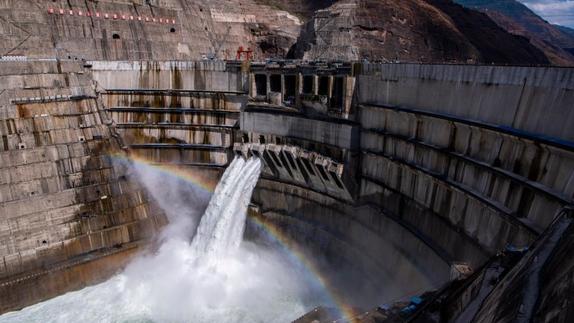 Aerial photo taken on May 13, 2021 shows the view of the Baihetan hydropower station under construction in China. (PHOTO/XINHUA)
Aerial photo taken on May 13, 2021 shows the view of the Baihetan hydropower station under construction in China. (PHOTO/XINHUA)
CHENGDU - The Baihetan hydropower station, the world's second-largest in terms of total installed capacity, went fully operational Tuesday in the upper section of the Yangtze River in southwest China, according to China Three Gorges Corporation.
Its operation marked the completion of the world's largest clean energy corridor, where six mega hydropower stations on the Yangtze work to transmit electricity from the resource-rich west to energy-consuming regions in the east.
(The) Baihetan (hydropower station) signifies a major breakthrough in China's high-end equipment manufacturing, as it is equipped with 16 home-grown hydro-generating units, each with a capacity of 1 million kilowatts, the largest single-unit capacity in the world.
Lei Mingshan, chairman of China Three Gorges Corporation
Baihetan's full operation came after the last of its 16 hydro-generating units completed a 72-hour trial operation on Tuesday morning. With a total installed capacity of 16 million kilowatts, Baihetan is second only to the Three Gorges Dam project in the central Chinese province of Hubei.
"Baihetan signifies a major breakthrough in China's high-end equipment manufacturing, as it is equipped with 16 home-grown hydro-generating units, each with a capacity of 1 million kilowatts, the largest single-unit capacity in the world," said Lei Mingshan, chairman of China Three Gorges Corporation.
The full operation of Baihetan is of great significance to China's shift in energy structure, the construction of the Yangtze River Economic Belt, and the coordinated development of the regional economy in the country, Lei added.
ALSO READ: Primary work starts at Baihetan dam
The six hydropower stations on the Yangtze River, all run by the corporation, are expected to generate 300 billion kilowatt-hours of electricity every year, reducing coal consumption by 90 million tonnes and carbon emissions by 248 million tonnes.
Four of them - Wudongde, Baihetan, Xiluodu, and Xiangjiaba - are located on the Jinsha River, the upper section of the Yangtze River, while the other two - Three Gorges Dam and Gezhouba - are on the middle section of the Yangtze.
Collectively, they account for about one-fifth of China's total hydropower installed capacity, forming a 1,800-km-long clean energy corridor that also plays a major role in flood control, shipping, water resources utilization, and ecological security in the Yangtze River Basin.
"The full operation of Baihetan - as well as the completion of the world's largest clean energy corridor - combine to mark a new chapter in the harmonious coexistence of man and nature, and also epitomize our great efforts towards Chinese modernization," said Lei.
ALSO READ: Mega hydropower project in SW China to operate in 2020
The hydropower station will generate an average of more than 62.4 billion kilowatt-hours of electricity every year, sufficient for the annual electricity consumption of approximately 75 million people
For engineers and experts alike, Baihetan is a significant construction feat in terms of scale, technological difficulty, and complex geographic conditions.
The hydropower station will generate an average of more than 62.4 billion kilowatt-hours of electricity every year, sufficient for the annual electricity consumption of approximately 75 million people.
He Wei, Party chief of the construction department of the Baihetan project, took pride in contributing to the construction of the "100 percent made-in-China" hydropower station.
"Having participated in the construction of Three Gorges Dam and Baihetan, two world-leading hydropower projects, I bear witness to China's technological leap in this field," said He.
Eddie Rich, CEO of the International Hydropower Association, hailed Baihetan as a mega project that has overcome some of the most difficult technical challenges ever faced by hydropower engineers.
The successful completion of the project "represents technological advances across the whole lifecycle of hydropower, from design and planning, to material science and equipment manufacturing, and construction technologies and intelligent management," said Rich.
READ MORE: Massive hydropower dam to help country meet carbon neutrality goal
Baihetan, which straddles the provinces of Yunnan and Sichuan, is located in a region with fragile ecological conditions and which is prone to geographic disasters.
Environmental protection had been high on the agenda during its construction. Projects such as ecological restoration of the Heishui River habitat, stratified intake facilities and botanical gardens, were implemented to build an ecological barrier in the upper reaches of the Yangtze River, according to China Three Gorges Corporation.


